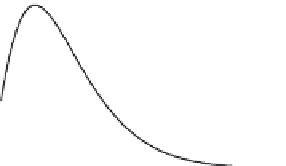Geoscience Reference
In-Depth Information
1.5
(e
2
x
+
)u
+2
x
+
=20
1
5
0.5
1
0
0
1
2
3
4
5
6
6
t
+
/(e
2
x
+
)
Fig. 5.8 Dimensionless representation of the second part of the unit response function
u
+
2
=
h
0
u
2
/
(
S
0
V
0
) for the upstream inflow problem, as obtained by solution of the linearized
complete shallow water equations. Each curve is shown as a function of time
t
+
at different
distances
x
+
downstream from the release point of the unit impulse. The values of the ordinate
and the abscissa are multiplied and divided, respectively, by (
e
2
x
+
) to allow convenient
comparison between the three curves. The constant is
e
2
=
Fr
0
/
(Fr
0
+
1) and the Froude
number is taken as Fr
0
=
0
.
5.
Several features of the solution can be brought out in a more general way by considering
it in a similarity framework. Inspection of the solution suggests that for this purpose one
can define a dimensionless distance along the channel, and a dimensionless time, as follows
S
0
x
h
0
S
0
V
0
t
h
0
x
+
=
and
t
+
=
(5.78)
Recalling the definitions given in Equations (5.50), (5.63) and (5.64), one can readily express
the two parts of the solution in terms of these dimensionless variables. Thus one obtains
from (5.73),
u
1
=
exp(
−
e
1
x
+
)
δ
(
t
+
−
e
2
x
+
)
(5.79)
(Fr
0
+
in which the constants depend only on the Froude number, namely
e
1
=
(1
−
a
Fr
0
)
/
Fr
0
) and
e
2
=
1). In a similar way, (5.74) yields the second part of the unit
response in terms of the dimensionless variables
Fr
0
/
(Fr
0
+
S
0
V
0
h
0
e
4
x
+
τ
+
u
2
=
exp (
ax
+
−
e
5
t
+
) I
1
(
e
6
τ
+
) H (
t
+
−
e
2
x
+
)
(5.80)
where
τ
+
=
[(
t
+
−
e
2
x
+
)(
t
+
−
e
3
x
+
)]
1
/
2
,
a
is defined in Equations (5.39) and (5.43),
and the remaining constants are
e
3
=
Fr
0
/
(Fr
0
−
1),
e
4
=
[(1
−
a
2
Fr
0
)
/
(1
−
Fr
0
)]
1
/
2
/
Fr
0
,
e
5
=
(
a
Fr
0
+
1)
/
Fr
0
, and
e
6
=
[(1
−
a
2
Fr
0
)(1
−
Fr
0
)]
1
/
2
/
Fr
0
. This second part is shown in
Figure 5.8 as a function of
t
+
, as it would be observed at different distances
x
+
from the
point of release of the unit impulse. To allow an easier display of the evolution of the shape
of this wave and a comparison between the different curves, in the figure
t
+
is scaled in
the abscissa with
x
+
, and
u
2
is scaled in the ordinate with
x
−
1
+
; therefore the horizontal




























































































